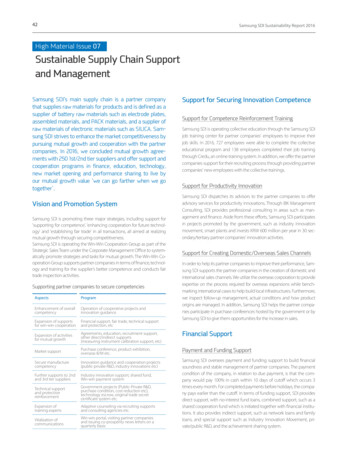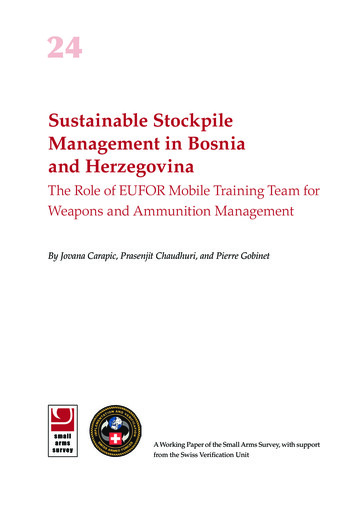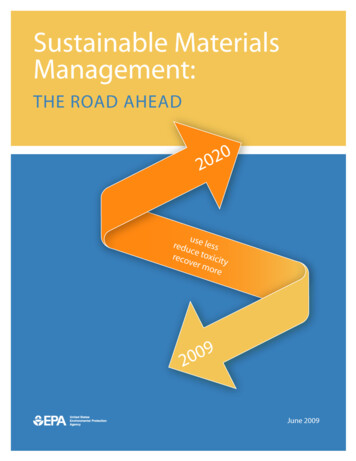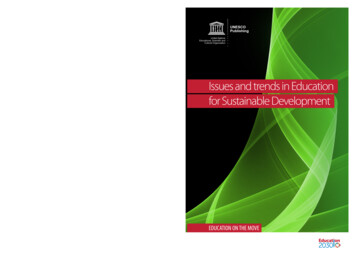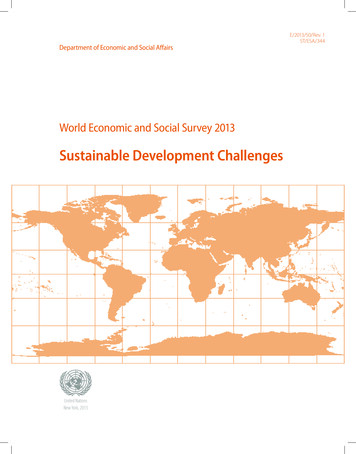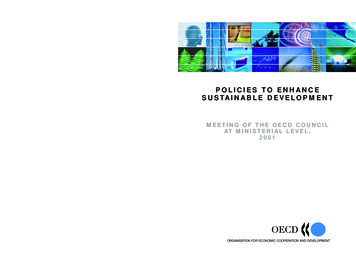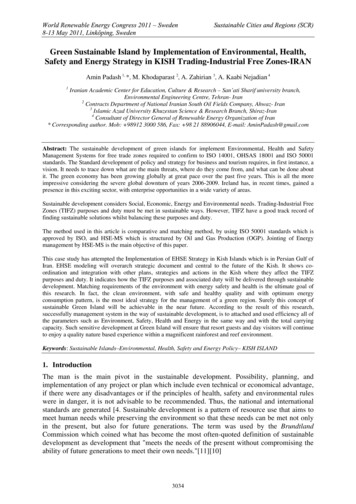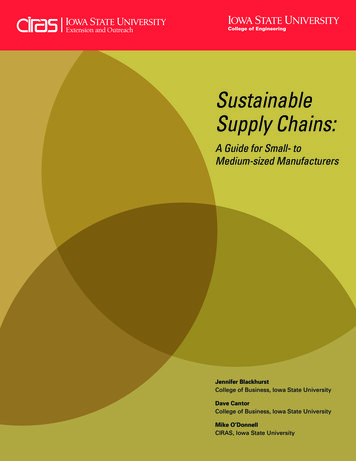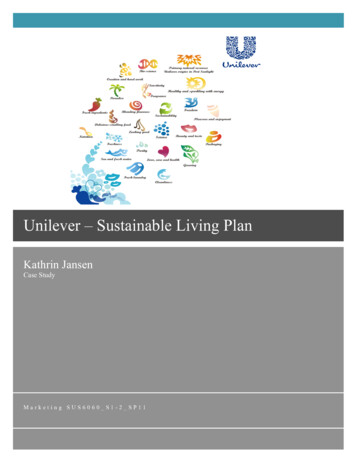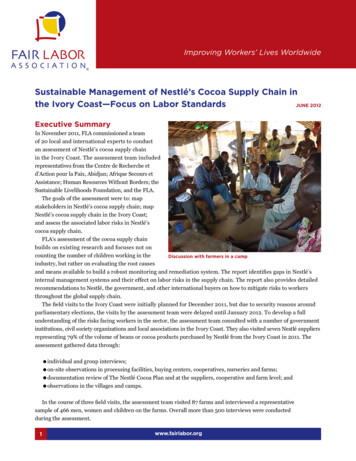
Transcription
Improving Workers’ Lives WorldwideSustainable Management of Nestlé’s Cocoa Supply Chain inJune 2012the Ivory Coast—Focus on Labor StandardsExecutive SummaryIn November 2011, FLA commissioned a teamof 20 local and international experts to conductan assessment of Nestlé’s cocoa supply chainin the Ivory Coast. The assessment team includedrepresentatives from the Centre de Recherche etd’Action pour la Paix, Abidjan; Afrique Secours etAssistance; Human Resources Without Borders; theSustainable Livelihoods Foundation, and the FLA.The goals of the assessment were to: mapstakeholders in Nestlé’s cocoa supply chain; mapNestlé’s cocoa supply chain in the Ivory Coast;and assess the associated labor risks in Nestlé’scocoa supply chain.FLA’s assessment of the cocoa supply chainbuilds on existing research and focuses not oncounting the number of children working in theDiscussion with farmers in a campindustry, but rather on evaluating the root causesand means available to build a robust monitoring and remediation system. The report identifies gaps in Nestlé’sinternal management systems and their effect on labor risks in the supply chain. The report also provides detailedrecommendations to Nestlé, the government, and other international buyers on how to mitigate risks to workersthroughout the global supply chain.The field visits to the Ivory Coast were initially planned for December 2011, but due to security reasons aroundparliamentary elections, the visits by the assessment team were delayed until January 2012. To develop a fullunderstanding of the risks facing workers in the sector, the assessment team consulted with a number of governmentinstitutions, civil society organizations and local associations in the Ivory Coast. They also visited seven Nestlé suppliersrepresenting 79% of the volume of beans or cocoa products purchased by Nestlé from the Ivory Coast in 2011. Theassessment gathered data through: individual and group interviews; on-site observations in processing facilities, buying centers, cooperatives, nurseries and farms; documentation review of The Nestlé Cocoa Plan and at the suppliers, cooperative and farm level; and observations in the villages and camps.In the course of three field visits, the assessment team visited 87 farms and interviewed a representativesample of 466 men, women and children on the farms. Overall more than 500 interviews were conductedduring the assessment.1www.fairlabor.org
Stakeholder MappingContentsExecutive Summary. 1I. Introduction. 4II. Background. 61. The Cocoa Sector in the Ivory Coast. 62. Nestlé’s Strategy Related to Cocoa Sourcingin the Ivory Coast. 8III. Methodology.111. Assessment Team.112. Assessment Stages.113. Stakeholder Engagement.134. Data Collection.145. Tools for Data Collection.18IV. Findings.181. Stakeholder Mapping.18a. Governmental Stakeholders.19b. Non-Governmental Stakeholders.21c. Local Communities and Village LevelCommittees. 23d. Conclusions of Stakeholder Mapping. 232. Supply Chain Mapping. 25a. Supply Chain Actors. 25b. Cocoa Bean Processing andProcurement. 29c. Farm Profile and Estimated Volumes.31d. Conclusions of Supply Chain Mapping.313. Risk Assessment. 323.1 Task and Risk Mapping. 323.2 Risks in Internal Management Systems.34a. Policies.34b. Procedures. 35c. Results. 38d. Conclusions on Internal ManagementSystems. 393.3 Labor Risk Assessment. 40a. Employment Relationship. 40b. Forced Labor.41c. Child Labor.41d. Harassment or Abuse.46e. Non-Discrimination.46f. Health, Safety, Environment. 47g. Freedom of Association andCollective Bargaining.50h. Hours of Work.51i. Compensation. 52j. Conclusions on Labor Standards Risks.54V. Overall Conclusions. 55VI. Recommendations. 56a. To the Government of the Ivory Coast. 56b. To Nestlé and Other Industry Members.57c. Future Research. 58Annex 1: Pictorial Journey of Cocoa Beans. 59Glossary.662The assessment team developed a comprehensive mapof stakeholders, including local and national actors in thegovernmental, nongovernmental, and private sectors.Most existing programs and stakeholder effortsconcentrate on the elimination of the worst forms ofchild labor rather than on aspects such as forcedlabor, wages and benefits, and health and safety eventhough they could have a causal effect on thepresence of child labor.Supply Chain MappingThe assessment team mapped the cocoa supply chainin great detail, including Nestlé’s headquarters inSwitzerland R&D in Abidjan and local operations in theIvory Coast; Tier 1 suppliers of Nestlé1; subsidiaries inWest Africa of Tier 1 suppliers; processing facilities andbuying centers in the Ivory Coast; third-party serviceproviders; traitants; cooperatives; pisteurs; farmers;sharecroppers; and workers.Cocoa procurement in the Ivory Coast occurs toa large extent (80-85%) outside of cooperatives andthrough the “unorganized” sector, involving manyintermediaries. The majority of the actors (pisteurs,coxers and farmers) are not registered. Cooperativesinvolved in the sustainability programs of companiesexporting cocoa from the Ivory Coast make up a smallproportion of the cocoa market. Additionally, thesupply chains are not stable, as participants sell and buyfrom anyone. Furthermore, competition around goodquality suppliers is intense and cooperatives maintainrelationships with several buyers and adjust thevolume supplied to them depending on the terms theyare offered. This instability in the supply chain maketransparency, monitoring and remediationefforts challenging.Risk AssessmentThe assessment of risks in Nestlé’s cocoa supplychain focused on child labor; the presence andeffectiveness of the internal management systemswithin Nestlé’s supply chain with regard to laborrights; and adherence to labor standards embodied inthe FLA Workplace Code of Conduct and ComplianceBenchmarks. A complete analysis of the risks relatedto Nestlé’s internal systems, along with an overviewof associated risks with respect to the FLA Code ofwww.fairlabor.org
Conduct, can be found in Section IV.3.Children are at risk in every phase of cocoa production.Such risks include injury from machetes during thepreparation of the land, maintenance of the farm andharvesting of the cocoa beans; injury from physicalstrain during the nursing and planting of seedlings aswell as carrying heavy loads; and exposure to harmfulchemicals in the application of fertilizers and pesticides.A full description of child labor risks can be found inTable 10.The Nestle Cocoa Plan (TNCP) offers a good startingpoint to improve labor conditions on cocoa farms inthe Ivory Coast because its components could provideholistic solutions to mitigate some of the issues thecocoa sector is grappling with apart from child labor. Tomake TNCP a well-rounded developmental program,some improvements have to be made, followed by thescaling up of the program.ConclusionsAmong the main conclusions of FLA are:Nestlé, due to its leverage and the volume ofbeans procured, is well positioned to make a largepositive impact on the livelihoods of workers inthe cocoa supply chain.The Nestlé Cocoa Plan and participation in otherinitiatives provide the building blocks for a morerobust and deep reaching program.With some adjustments and improvements, TNCPhas the makings of a well-rounded developmentalprogram. Enhanced monitoring and increasedaccountability from the various tiers of suppliers isa must to make the supply chain more sustainable.Several risks in terms of labor standards havebeen identified, especially in the areas child labor,forced labor, health and safety, discrimination andcompensation.Child labor is still a reality on cocoa farms in theIvory Coast and has its roots in a combinationof factors. A realistic strategy to eliminate childlabor in the Ivory Coast needs to start with theattitudes and perceptions of the various actors inthe supply chain and communities at large. Onecompany alone cannot solve all the problems oflabor standards that prevail in the cocoa sector ofthe Ivory Coast.Large parts of the supply chain are shared with Suggestions box at a TNCP cooperative 3 other industry actors. All parties should thereforecombine forces in enhancing supply chain mappingand transparency, monitoring and capacitybuilding programs.Besides efforts from the private sector, farmersand their communities, the role of governmentis crucial in the development of a sustainablecocoa sector.RecommendationsThe report makes a number of recommendations, including:To the Government of the Ivory CoastConsider filling regulatory gaps with respect tolabor standards in the agriculture sectorConsider establishing a national registrationsystem for farmers and pisteursConsider developing a sector-wide sustainabilitystandard for cocoa with multi-stakeholderengagementContinuously improve the child labor monitoringand rehabilitation systemBroaden the scope of the Agents (Relais) under the www.fairlabor.org
“Système de Suivi du Travail des Enfants” (SSTE)Target remote communities with ruraldevelopment interventionsFoster alternative income generation andemployment generation at the village levelAddress problems posed by the lack of schoolsand teachersTo Nestlé and other Industry MembersStrengthen Nestlé’s supplier Code of ConductIncrease awareness and understanding aboutthe Nestlé Code of Conduct amongst upstreamsuppliersDefine clear roles and responsibilities for Nestlé,staff, suppliers, cooperatives and farmersInclude comprehensive key performance indicatorsand reporting requirements on labor standardsIncrease awareness among farmers about thepolicy of financial premiumsDevelop a robust internal monitoring andremediation systemExamine the role that cooperatives and otherestablished localities could play as a hub forextension servicesFacilitate collaboration and communicationbetween local and international stakeholdersScale up efforts for the Nestlé Cocoa Plan in thestandard supply chainAddress the issue of child labor through immediatesteps involving a bottom-up approach.Create alternative income creation opportunitiesfor farmers and their families I. IntroductionBased on the Memorandum of Understanding onCooperation between Nestlé and the Fair LaborAssociation (FLA) of July 28, 2011, Nestlé invited theFLA to conduct an assessment of their cocoa supplychain in the Ivory Coast.2The Fair Labor Association Inc. (FLA) is a non-profitorganization that combines the efforts of business,civil society organizations, and colleges and universitiesto promote and protect workers’ rights and to improveworking conditions globally through adherence tointernational standards.4Another way of explaining Good Agricultural PracticesThe objectives of this assessment are as follows:1. Mapping of stakeholders in Nestlé’s cocoa supplychain2. Mapping of Nestlé’s cocoa supply chain in theIvory Coast3. Assessment of the associated risks in Nestlé’s cocoasupply chainThe study is not intended to generate anotherestimate about the number of children working in cocoaproduction, but to capture the risks and causes of childlabor in Nestlé’s supply chain and the means availableto build a robust monitoring and remediation system.Nevertheless, since child labor is identified as the priorityissue in the cocoa sector in the Ivory Coast, it is reportedin some detail in this report. Several other aspects ofworking conditions are also analyzed that may have aneffect on, and are in turn affected by, child labor.The assessment process follows the FLA’s sustainablecompliance methodology (See Box 1) that starts withwww.fairlabor.org
box 1FLA’s Sustainable Compliance Methodology for the Agricultural SectorThe cultural and socio-demographic conditions in the agricultural sector call for a strategy basedon socio-economic empowerment as opposed to auditing. The FLA’s sustainable compliancemethodology is an innovative approach that aims at filling the gaps left by the pure audit method,which mainly identifies compliance violations and provides “quick fix” solutions to improve the nextround of results. FLA’s approach overcomes this weakness and strengthens the capacity of suppliersand workers to improve and eventua
long-term view and looking at Nestlé’s supply chain management practices and assessing how Nestlé manages labor risks. Therefore, the report highlights gaps in internal management systems and their effect on labor risks in the supply chain followed by recommendations to mitigate those risks. The findings in this report represent a first step
